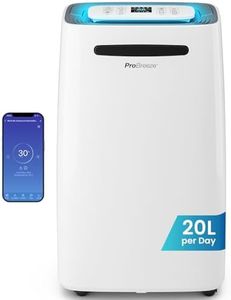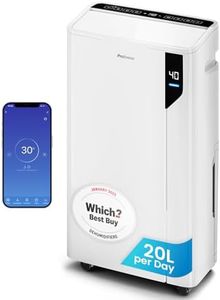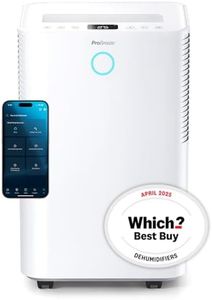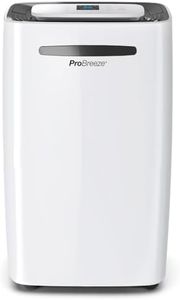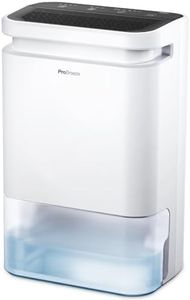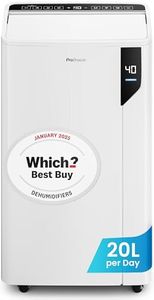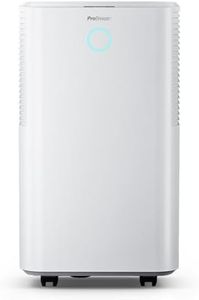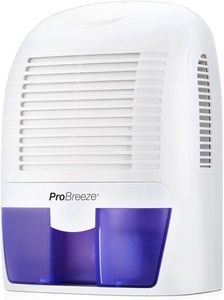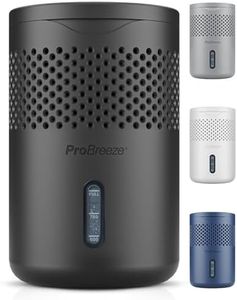We Use CookiesWe use cookies to enhance the security, performance,
functionality and for analytical and promotional activities. By continuing to browse this site you
are agreeing to our privacy policy
10 Best Pro Breeze Dehumidifiers
From leading brands and best sellers available on the web.Buying Guide for the Best Pro Breeze Dehumidifiers
When choosing a dehumidifier, it's important to consider the specific needs of your space and the conditions you are dealing with. Dehumidifiers are essential for controlling humidity levels in your home, which can help prevent mold growth, reduce allergens, and improve overall air quality. Understanding the key specifications will help you select a dehumidifier that effectively manages moisture in your environment.Capacity (Pints per Day)Capacity refers to the amount of moisture a dehumidifier can remove from the air in a 24-hour period, usually measured in pints. This is important because it determines how effective the dehumidifier will be in a given space. Smaller units, removing around 20-30 pints per day, are suitable for small rooms or areas with mild humidity. Medium units, handling 30-50 pints, are ideal for medium-sized spaces or moderate humidity. Larger units, removing 50+ pints, are best for large areas or very damp conditions. Choose a capacity that matches the size of your space and the level of humidity you need to control.
Coverage AreaCoverage area indicates the maximum square footage a dehumidifier can effectively manage. This is crucial for ensuring the unit can handle the size of the room or area you intend to use it in. Small dehumidifiers typically cover up to 300 square feet, medium ones can handle 300-700 square feet, and large units can cover over 700 square feet. To select the right coverage, measure the area of the space you need to dehumidify and choose a model that can handle slightly more than that to ensure efficiency.
Energy EfficiencyEnergy efficiency is about how much electricity the dehumidifier uses to remove moisture. This is important for keeping your energy bills low and reducing environmental impact. Look for models with an Energy Star rating, which indicates they meet energy efficiency guidelines. More efficient models will use less electricity for the same amount of moisture removal, making them cost-effective in the long run. Consider your usage patterns and opt for an energy-efficient model if you plan to run the dehumidifier frequently.
Noise LevelNoise level refers to how loud the dehumidifier is when operating, usually measured in decibels (dB). This is important if you plan to use the dehumidifier in a living space or bedroom where noise could be disruptive. Dehumidifiers typically range from 30 dB (quiet) to 60 dB (louder). If noise is a concern, look for models that specify a lower decibel level or have a 'quiet mode' feature. Consider where you will place the dehumidifier and how sensitive you are to noise when making your choice.
Drainage OptionsDrainage options refer to how the dehumidifier disposes of the collected water. This is important for convenience and maintenance. Some models have a removable water tank that needs to be manually emptied, while others offer continuous drainage through a hose connection. If you prefer less maintenance, a model with a continuous drainage option might be ideal, especially for high humidity areas. Consider how often you can empty the tank and whether you have access to a suitable drainage point when choosing.
Additional FeaturesAdditional features can enhance the functionality and convenience of a dehumidifier. These may include a built-in humidistat to automatically maintain desired humidity levels, a timer for scheduled operation, or a filter to improve air quality. Some models also offer smart connectivity for remote control via a smartphone app. Consider which features are important to you based on your lifestyle and the specific needs of your space. Additional features can add convenience but may also increase the complexity and cost of the unit.


